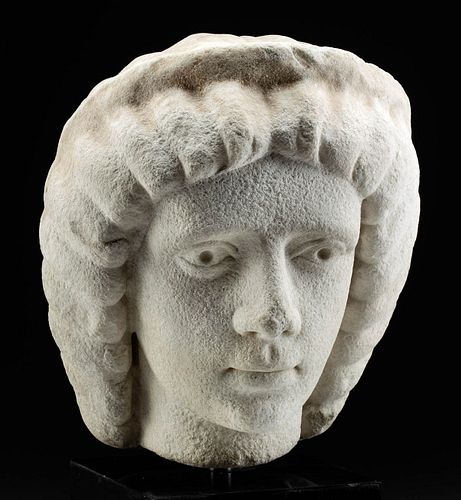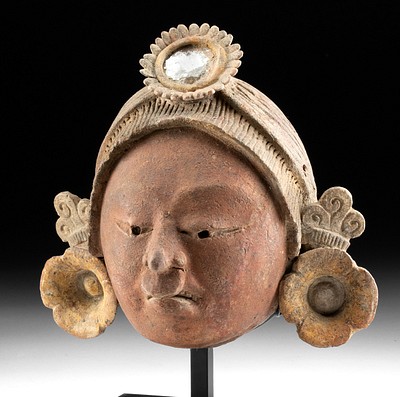Roman Marble Head of a Female, ex-Anthony Quinn
Lot 19
About Seller
Artemis Fine Arts
686 S Taylor Ave, Ste 106
Louisville, CO 80027
United States
Selling antiquities, ancient and ethnographic art online since 1993, Artemis Gallery specializes in Classical Antiquities (Egyptian, Greek, Roman, Near Eastern), Asian, Pre-Columbian, African / Tribal / Oceanographic art. Our extensive inventory includes pottery, stone, metal, wood, glass and textil...Read more
Estimate:
$9,000 - $18,000
Absentee vs Live bid
Two ways to bid:
- Leave a max absentee bid and the platform will bid on your behalf up to your maximum bid during the live auction.
- Bid live during the auction and your bids will be submitted real-time to the auctioneer.
Bid Increments
| Price | Bid Increment |
|---|---|
| $0 | $25 |
| $300 | $50 |
| $1,000 | $100 |
| $2,000 | $250 |
| $5,000 | $500 |
| $10,000 | $1,000 |
| $20,000 | $2,500 |
| $50,000 | $5,000 |
| $100,000 | $10,000 |
| $200,000 | $20,000 |
About Auction
By Artemis Fine Arts
Jul 14, 2022
Set Reminder
2022-07-14 10:00:00
2022-07-14 10:00:00
America/New_York
Bidsquare
Bidsquare : Exceptional Antiquities Ethnographica Fine Art
https://www.bidsquare.com/auctions/artemis-gallery/exceptional-antiquities-ethnographica-fine-art-9692
Museum-worthy examples of classical antiquities (Egyptian, Greek, Roman, Near Eastern), Viking, Far East / Asian, Pre-Columbian, African / Tribal, Oceanic, Native American, Spanish Colonial, Fossils, Ancient Jewelry, Fine / Visual Arts, so much more! Artemis Fine Arts info@artemisgallery.com
Museum-worthy examples of classical antiquities (Egyptian, Greek, Roman, Near Eastern), Viking, Far East / Asian, Pre-Columbian, African / Tribal, Oceanic, Native American, Spanish Colonial, Fossils, Ancient Jewelry, Fine / Visual Arts, so much more! Artemis Fine Arts info@artemisgallery.com
- Lot Description
Roman, Imperial Period, ca. 2nd to 3rd century CE. A splendid marble head of a female, gazing downward from wide, almond-shaped eyes with pierced pupils. Crowned by a graceful headband, her coiffure is arranged in a Severan style made popular by Julia Domna (160 to 217 CE) with thick waves that frame her sweet visage and a large bun on the verso. Elegant features comprise her attractive countenance, which boasts a straight brow, a naturalistic nose, soft lips held in a gentle smile, and a pointed chin. Note the artist's ability to render life from stone via careful attention to detail, as seen in her protruding chin and pronounced philtrum. An exceptional example, replete with artistic virtuosity! Size: 8" W x 10.1" H (20.3 cm x 25.7 cm); 16.4" H (41.7 cm) on included custom stand.
The hairstyle worn by this portrait was inspired by Julia Domna, wife of the emperor Septimius Severus (r. 193 to 211 CE), mother of the emperor Caracalla (r. 211 to 217 CE). She was the daughter of a high-ranking priest from Syria, and some believe that her hairstyle was inspired by her foreign origins - indeed, women from Palmyra were known to wear their hair in a center parting with diadems or turbans.
Marble statuary, reliefs, and cladding were ubiquitous in the Roman world, as the remains of the preserved cities at Herculaneum and Pompeii demonstrate. Their sculpture was intended to conjure human vitality, and was inspired by the works of Polykleitos, who became the model to which sculptors aspired in Greco-Roman as well as later Western European art. Greco-Roman statuary, unlike that of the other Mediterranean civilizations like Egypt, Persia, etc., celebrated the naturalistic human form. This included representations of their gods and the elite, who appear dressed as ordinary, living citizens. This suggests an intriguing, more personal relationship with the gods rather than the more abstract or magical portrayals of other contemporary societies. This head may have been part of a public display like the Severan-period Septizodium, the monumental fountain built to honor the imperial family, and which had a three-story columnar façade decorated with portraits of various gods and goddesses.
Provenance: ex-private collection of actor Anthony Quinn and his wife Katherine, Bristol, Rhode Island, USA acquired prior to 2000
All items legal to buy/sell under U.S. Statute covering cultural patrimony Code 2600, CHAPTER 14, and are guaranteed to be as described or your money back.
A Certificate of Authenticity will accompany all winning bids.
PLEASE NOTE: Due to recent increases of shipments being seized by Australian & German customs (even for items with pre-UNESCO provenance), we will no longer ship most antiquities and ancient Chinese art to Australia & Germany. For categories of items that are acceptable to ship to Australia or Germany, please contact us directly or work with your local customs brokerage firm.
Display stands not described as included/custom in the item description are for photography purposes only and will not be included with the item upon shipping.
#169269Fragment of a larger piece. Rough surface due to repeated cleanings and resurfacing. Retouching to features. Chipping to nose. Expected nicks and abrasions throughout, commensurate with age. Otherwise, excellent.Condition
- Shipping Info
-
All shipping is handled in-house for your convenience. Your invoice from Artemis Gallery will include shipping calculation instructions. If in doubt, please inquire BEFORE bidding for estimated shipping costs for individual items.
-
- Buyer's Premium



 EUR
EUR CAD
CAD AUD
AUD GBP
GBP MXN
MXN HKD
HKD CNY
CNY MYR
MYR SEK
SEK SGD
SGD CHF
CHF THB
THB














